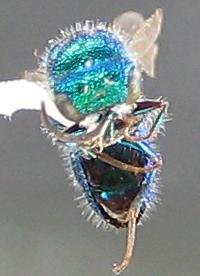
Native Bee Inventory and Monitoring Lab; Photographer: Erika Tucker · 1
Chrysis montana, face |
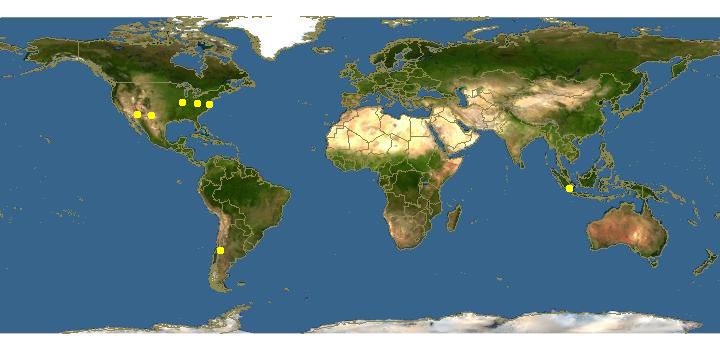
Click on map for details about points.
|
80x5 -
240x3 -
240x4 -
320x1 -
320x2 -
320x3 -
640x1 -
640x2
Set display option above.
Click on
images to enlarge. |
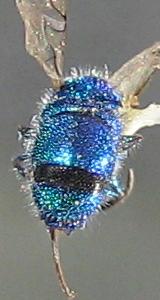
Native Bee Inventory and Monitoring Lab; Photographer: Erika Tucker · 1
Chrysis montana, tail |
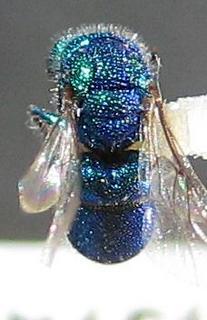
Native Bee Inventory and Monitoring Lab; Photographer: Erika Tucker · 1
Chrysis montana, top |
|
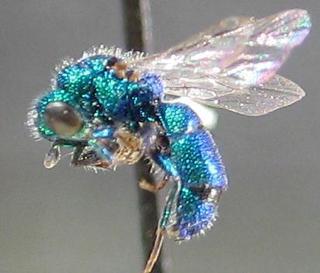
Native Bee Inventory and Monitoring Lab; Photographer: Erika Tucker · 1
Chrysis montana |
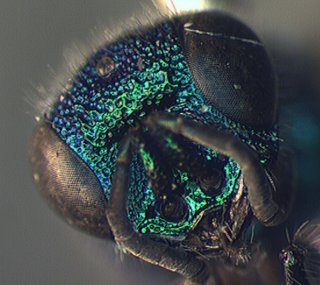
Native Bee Inventory and Monitoring Lab; Photographer: Erika Tucker · 1
Chrysis montana, female, face |
|
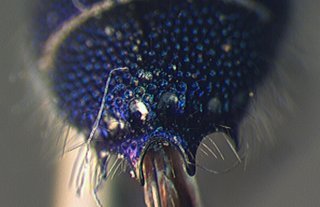
Native Bee Inventory and Monitoring Lab; Photographer: Erika Tucker · 1
Chrysis montana, female, tail |
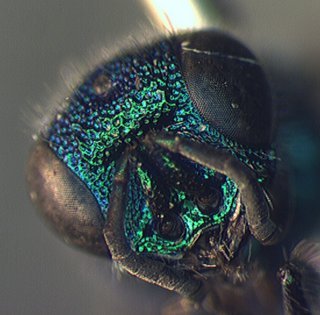
Native Bee Inventory and Monitoring Lab; Photographer: Erika Tucker · 1
Chrysis montana, female. face |
|
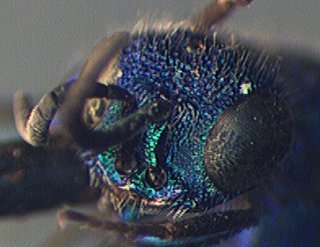
Native Bee Inventory and Monitoring Lab; Photographer: Erika Tucker · 1
Chrysis montana, male, face |
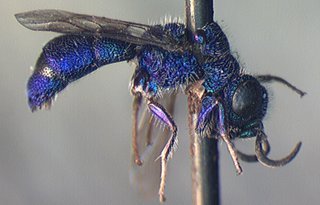
Native Bee Inventory and Monitoring Lab; Photographer: Erika Tucker · 1
Chrysis montana, male, side |
|
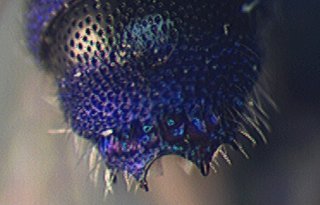
Native Bee Inventory and Monitoring Lab; Photographer: Erika Tucker · 1
Chrysis montana, male, tail |
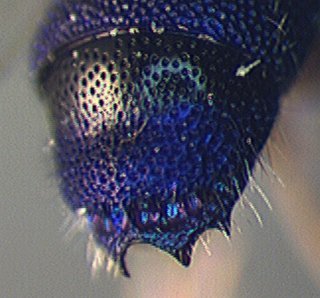
Native Bee Inventory and Monitoring Lab; Photographer: Erika Tucker · 1
Chrysis montana, male, teeth |
|
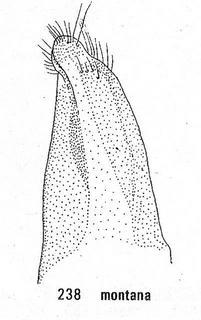
R. M. Bohart and L. S. Kimsey · 1
Chrysis montana, male paramere |
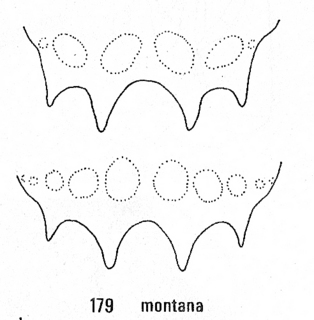
R. M. Bohart and L. S. Kimsey · 1
Chrysis montana, tail |
|
Overview |
Taken from:
R. M. Bohart and L. S. Kimsey. 1982. A Synopsis of the Chrysididae in America North of Mexico.
Chrysis montana Aaron
(Figs. 179, 238)
Chrysis montana Aaron 1885:234. Lectotype female, Montana (ANSP).
Chrysis hirsuta Aaron 1885:235. Lectotype male, Utah (ANSP). Nec hirsuta Gerstaeker 1869.
Chrysis aaroni Mocsary 1889:386. New name for hirsuta Aaron.
Discussion: A recent reexamination of the types of montana and hirsuta confirms the fact that they are a pair of the same species. Relationships with equidens and corrected synonymy are given under that species. Among all the species of the dorsalis group, montana has the longest and sharpest teeth on T-III. This alone is usually enough to distinguish it (fig. 179). Also unusual is the frequent trace of a frontal carina in the prominent brow of females. Male F-I is a little shorter than in most other species, 1.8 times as long as broad, similar to that of equidens. Male genitalia are distinctive, the paramere with a somewhat buttonlike rounded apex (fig. 238). Modal body length is 5.0 mm in male and 6.0 mm in female.
Material examined: 33 males (including type of hirsuta), 41 females (including type of montana). The figures would be higher except that some previously identified specimens are not available for rechecking.
Distribution: Records are from the U.S. west of the Mississippi River. Outlying localities are IOWA (Sioux City), NEBRASKA (Lincoln), NEW MEXICO (Las Cruces), ARIZONA (Santa Catalina Mts., Flagstaff), WASHINGTON (near Goldendale), IDAHO (Lewiston), and CALIFORNIA (many records). The Upper Sonoran and Alleghanian Life Zones are favored.
Species group of dorsalis Aaron
Diagnosis: Male F-I longer than F-III and about 1.5-2.0 times as long as broad, female F-I 2.0-2.5 times; subantennal distance a little more or less than 1.0 MOD, shorter than malar space which is 1.5- 2.0 MOD, transverse frontal carina absent or rarely indicated (montana female); in which case eye height equals LID; genal carina separated from eye; midocellus not depressed or lidded; mesopleuron and metanotum rather simple; T-II with a weak and ill-defined median longitudinal ridge; T-III distally with a simple edge and four teeth, laterally a little irregular but essentially straight.
Included species: allectoris Bohart, dorsalis Aaron, equidens Viereck, knowltoni Bohart, Aaron, montana Aaron, paradisica Bohart, pompella Bohart, provancheri Schulz, and scitula Cresson.
Discussion: External characters for species separation are meager in some cases. However, male genitalia, particularly the parameres, are usually definitive (figs. 230-239). Two essential characteristics of these relatively small species are the absence of a definite frontal carina and a moderately long male F-I. The coppery to red coloration in three of the species is unusual among American Chrysis.
Hosts: probably ground nesting bees or wasps (see comments under dorsalis).
Key to the Chrysis dorsalis group
1. Body with extensive coppery to gold or reddish, at least on abdomen ………………..2
Body green to blue to purple, often with some black …………………………………4
2. Color of abdomen not contrasting strongly with that of thorax and head, basic body color green but infused with coppery to golden ……………………………….meta Aaron
Color of abdomen contrasting strongly with that of thorax and head, abdomen usually
extensively coppery red with thorax and head predominantly blue or greenish blue …….3
3. Wings brown stained, scutellum closely and rather coarsely punctate ………………………………………………………………………….provancheri Schulz
Wings nearly clear, scutellum with small polished areas between many small punctures …………………………………………………………………pompella Bohart
4. S-II apically and S-III brown, except usually for a basomedian greenish spot on S-III.. . . …………………………………………………………………………..equidens Viereck
S-II apically or subapically and S-III extensively green to blue ……………………….5
5. T-III with more lateral teeth obtuse and not sharp, all four teeth usually weakly
developed (fig. 182), pit row often shallow, scapal basin extensively polished medially ……………………………………………………………………………scitula Cresson
T-III with more lateral teeth acute (rarely obtuse) and sharp, all four teeth well
developed, pit row deep, scapal basin various ……………………………………………6
6. T-III punctation moderately coarse and rather even, not much finer toward base of colored area; median notch at apex of T-III usually more than a semicircle (fig. 179); frontal brow often with traces of a cross carina …………………………...montana Aaron
T-III punctation coarse toward pit row but becoming much finer on average toward base of colored area, median notch at apex of T-III usually less than a semicircle; frontal brow various ……………………………………………………………………………7
7. T-III with more median pair of teeth almost as sharp as lateral teeth (fig. 180) ……...8
T-III with more median pair of teeth usually considerably more blunt than lateral
teeth (fig. 178) ……………………………………………………………………………9
8. California Sierra along east side from Nevada Co. to Mono Co …………………………………………………………………………...paradisica Bohart
East of 100th meridian ………………………………………………..a1lectoris Bohart
9. T-II with punctures across distal third mostly less than a PD apart, this area not particularly shiny; body length mostly 6-7 mm long ………………………dorsalis Aaron
T-II with punctures across distal third mostly about a PD apart, this area somewhat shiny; body length mostly 7-8 mm long ………………………………...knowltoni Bohart
|
|
| Supported by | |
Updated: 2024-05-04 07:32:17 gmt
|